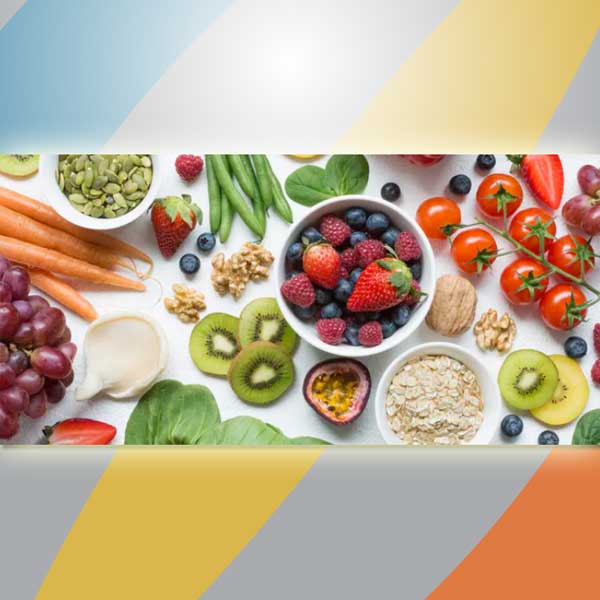FODMAP stands for Fermentable Oligo-, Di-, Mono-saccharides and Polyols. All these scientific terms are used to describe groups of fermentable carbohydrates that commonly trigger bloating, gas and stomach pain in people with sensitivities.
The main dietary sources of the four groups of FODMAPs include:
- Oligosaccharides: Wheat, rye, legumes and various fruits and vegetables, such as garlic and onions.
- Disaccharides: Milk, yogurt and soft cheese. Lactose is the main carbohydrate.
- Monosaccharides: Various fruit including figs and mangos, and sweeteners such as honey and agave nectar. Fructose is the main carb.
- Polyols: Certain fruits and vegetables including blackberries and lychee, as well as some low-calorie sweeteners like those found in sugar-free gum.
These foods are especially irritating to people who have been diagnosed with Irritable Bowel Syndrome (IBS). Many times people with IBS have less symptoms or less severe symptoms when they eat a diet that is low in FODMAPs foods. The benefits of a low-FODMAPs diet has been tested in thousands of people with IBS in more than 30 studies. People who have an IBS diagnosis have varied digestive symptoms which include stomach pain, bloating, reflux, gas and diarrhea or constipation. It has been found that a diet low in FODMAPs foods increased the quality of life dramatically, in many people with IBS; however 30% of people with IBS are not helped by a low-FODMAPs diet so it is important to work with your doctor to find what works best for you.
FODMAPs foods are prebiotics, which support growth of good gut bacteria. If you don’t have IBS, it is not beneficial to you to follow a low FODMAPs diet.
How to Follow a Low-FODMAP Diet
A low-FODMAP diet is time consuming and the process of learning what blend of foods your body can tolerate can be an expensive process. There is a lot of planning involved in finding out what foods to buy and avoid, getting rid of foods that you can’t eat and becoming aware of how you can prepare for dining in restaurants are all aspects of this process.
There are three stages in following a low-FODMAP diet these include:
- Restriction
- Reintroduction
- Personalization
Step 1 involves strictly avoiding all high-FODMAP foods. This step lasts 3-8 weeks depending on each person. FODMAP foods are important for good gut health so you don’t restrict all FODMAP foods forever. Many people experience positive benefits from restricting FODMAP foods within a week or so. If after 8 weeks you don’t see a change you should make an appointment to talk with your doctor about other options.
Step 2 includes reintroducing one FODMAP food by itself for 3 days. There are 2 reasons for this: 1) it helps to identify which types of FODMAPs you are able to tolerate and 2) it is important to discover the amount of FODMAPs you can tolerate. Although digestive stressors are painful and physically draining, eating FODMAP foods will not damage your body and are not like food allergies.
Step 3 is the stage where you create your own modified low-FODMAP diet by using the information you learned during step 2. This step is important because you must have a variety of foods in your diet in order to have a balanced diet with all the nutrition your body requires to be at its best.
High FODMAP Foods
Wheat is contained in so many foods like: bread, pasta, breakfast cereals, biscuits and pastries but also in small amounts in so many foods as thickeners and flavorings that even though, by itself, it is not, by weight, a high-FODMAP food, it is still the biggest contributor to FODMAPs in the United States.
Other grains can also be high-FODMAP sources like Rye, Amaranth, and Barley. However foods that include a fermentation process breaks down some FODMAPs into digestible sugars, which is why sourdough bread can be considered a low-FODMAP food.
Suggested low-FODMAP swaps for high-FODMAP grains are: Brown rice, Buckwheat, Maize, Millet, Oats, Polenta or Grits, Quinoa and Tapioca.
Garlic is one of the most concentrated sources of FODMAPs. It is used by itself and also as an ingredient as flavoring or natural flavor on ingredients listed on packaged foods. Dried garlic has three times more FODMAPs than fresh.
Suggested low-FODMAP swaps for garlic are: Chives, Chili, Fenugreek, Ginger, Lemongrass, Mustard seeds, Saffron and Turmeric.
Onions are another highly concentrated source of FODMAPs and like garlic it is commonly used to flavor so many foods that it is difficult to restrict it.
Suggested low-FODMAP swaps for onions are: Asafoetida is a pungent spice commonly used in Indian cooking. It should be cooked in hot oil first and added in small amounts.
Fruit is a FODMAP food because all fruit has fructose in it, however not all fruits are considered high-FODMAP foods. Fruits that contain high amounts of glucose alongside fructose are low-FODMAP foods because glucose helps your body absorb fructose. Low-FODMAP fruits do not tend to cause gut symptoms unless they are consumed in large amounts. For FODMAP sensitive people, a serving of fruit should be about 3 oz.
High-FODMAP fruits include: Apples, Apricots, Cherries, Figs, Mangoes, Nectarines, Peaches, Pears, Plums and Watermelon.
Low-FODMAP fruits include: Unripe bananas, Blueberries, Kiwi, Limes, Mandarins, Oranges, and Strawberries.
>>>Click Here for or a more extensive list of high-FODMAP foods
Vegetables are full of many nutrients that benefit our bodies but some vegetables are also high-FODMAP foods.
High-FODMAP vegetables include: Asparagus, Brussels sprouts, Cauliflower, Chicory leaves, Globe and Jerusalem artichokes, Karela, Leeks, Mushrooms and Snow peas.
Low-FODMAP vegetables include: Bean sprouts, Capsicum, Carrot, Choy sum, Eggplant, Kale, Tomato, Spinach and Zuccini.
Legumes and Pulses are a high-FODMAP food and notorious for causing gas and bloating. The way legumes and pulses are processed may lead them to have less FODMAPs, like canned lentils contain have half the FODMAPs that boiled lentils do, however a low-FODMAP diet includes very small portions of these foods.
High-FODMAP legumes and pulses include: Baked beans, Black-eyed peas, Broad beans, Butter beans, Chickpeas, Kidney beans, Lentils, Soybeans and Split peas.
Low-FODMAP vegetarian sources of protein include: Tofu, Eggs, Most nuts and seeds.
Sweeteners can be a hidden source of FODMAPs. Be careful to review ingredients lists on packaged foods.
High-FODMAP sweeteners include: Agave nectar, High-fructose corn syrup, Honey, Sorbitol, Mannitol, Xylitol or Isomalt.
Low-FODMAP sweeteners include: Glucose, Maple syrup, Sucrose, Sugar and Most artificial sweeteners like Aspartame, Saccharin and Stevia.
Dairy products that contain lactose are high-FODMAP foods. Matured cheeses lose a lot of their lactose in the cheesemaking process but if those same cheeses include flavorings like garlic and onion they are still a high-FODMAP food.
High-FODMAP dairy foods include: Cottage cheese, Cream cheese, Milk, Quark, Ricotta and Yogurt.
Low-FODMAP dairy foods include: Cheddar cheese, Cream, Feta Cheese, Lactose-free milk, and Parmesan Cheese.
Beverages can be a key source of FODMAPs. It is important to know what is in your beverages. Even low-FODMAP ingredients can become a high-FODMAP beverage because of the concentration of the ingredient, like orange juice. Certain teas and alcohol are also high-FODMAP items.
High-FODMAP beverages include: Chai tea, Chamomile tea, Coconut water, Dessert wine and Rum.
Low-FODMAP beverages include: Black tea, Coffee, Gin, Green tea, Peppermint tea, Vodka, Water and White tea.
People who are following a low-FODMAP diet will need to become familiar with specific names of high-FODMAP foods because it is important to read ingredients on packaged foods. Many food companies add FODMAPs to their foods as prebiotics or as fat or lower-calorie sugar substitutes to pre-fab foods. It is wise to limit processed foods as much as possible for most diets, including a low-FODMAP diet.
Often, pre-packaged foods have hidden sources of FODMAPs like:
- Onion
- Garlic
- Sorbitol
- Xylitol
Although garlic and onion are both high-FODMAP foods, and they are both common ingredients used to add flavor to foods there are many herbs and spices that you can learn to use to add great flavors to your foods. Also you can still get garlic flavor in your food, without eating garlic, by using garlic infused oils because FODMAPs are not fat-soluble so the flavor is left in the oil but the FODMAPs are not.
High-Flavor and Low-FODMAP Ingredients
- Asafoetida powder – available in Indian grocery stores
- Basil
- Chives
- Chili (be careful with this one)
- Coriander
- Cumin
- Fenugreek
- Ginger
- Lemongrass
- Lemon juice
- Lime juice
- Maple syrup
- Mustard seeds
- Parsley
- Pepper
- Rosemary
- Saffron
- Salt
- Spring onions (use the green part only)
- Thyme
- Turmeric
>>>Click here for even more information about using herbs and spices on a low-FODMAD diet
Low-FODMAP diet for Vegetarians
One staple food for vegetarians are legumes for their high protein content. Because legumes are a high-FODMAP food it is recommended that legumes not be ignored by vegetarians, but that they have very small portions. Serving size for vegetarians on a low-FODMAP is 1/4 cup. There are many other protein-rich food options for vegetarians so it is feasible that vegetarians with IBS can successfully follow a low-FODMAP diet. Some of these high-protein vegetarian options are:
- Tempeh
- Tofu
- Eggs
- Quorn (a meat substitute)
- Most nuts and seeds
Other Considerations
For people who are suffering from IBS, diet is important, but no diet will be affective if you are unable to reduce the stress in your life. Every person with high amounts of stress in their life must work to lower their stress levels or any pre-existing condition will flare up, or worse, be created in your body due to the constant high demands of life. Diet is just one component for a wellness lifestyle.
Please keep in mind that FODMAP foods are very good for you if you do not have IBS so it is not advisable to avoid them altogether.
>>>Read Self-Care Yourself to Wellness
If you are considering a low-FODMAP diet to help relieve symptoms of IBS remember to plan ahead, be patient with yourself and know that it may not work. If it does work remember that diet is just one part of being well. If you are needing help creating an action plan for your wellness please consider making an appointment with Karen G Clemenson. Karen is ready, willing and able to help you create a comprehensive wellness plan that incorporates all aspects of your wellness.
I hope that I have provided ample information about the FODMAPs Diet. I highly recommend them if you feel like you have IBS or you might benefit from this diet please make an appointment with your primary doctor; they will be able to advice you and refer you to proper specialists and nutrionists.
If you don’t want to research a specific wellness topic go to our Dear Jamie page and send an email to our Research Manager, Jamie Holloway, and someone from our team with write an article to answer your question.
Resources and Start Learning More:
- 10 Foods High in FODMAPs (and what to eat instead) by Megan Rossi, PhD, RD for Healthline
- A Beginner’s Guide to the Low-FODMAP Diet by Megan Rossi, PhD, RD for Healthline
- Adding flavor without adding symptoms by Monash FODMAP Team at Monash University
- High-FODMAP Foods by Michigan Medicine Staff
- Using herbs & spices on a low FODMAP diet by Monash FODMAP Team at Monash University
Related Articles
- Emotional Health is a Big Part of Wellness
- Brain Awareness & How to Take Care of Your Brain
- Why We Should Take Care of Our Feet
- Staying Healthy During Stressful Times aka Quarantine
- Staying Well During COVID-19
I hope this article helps Fuel Your Wellness. Please leave your comments below.
 Summer D Clemenson co-owns Clemenson Enterprises and Wellness Works NW with her wife, Karen G Clemenson. Their personal motto is Creativity, Honesty & Positivity are a must! This mantra helps them stay community and wellness minded in all they do. Summer is an Independent Wellness Advocate at dōTERRA. Summer also writes poetry and inspirational blogs @ ClemensonEnterprises.com. Her crochet art can be viewed and purchased @ KnottyWares.com & she loves special orders!
Summer D Clemenson co-owns Clemenson Enterprises and Wellness Works NW with her wife, Karen G Clemenson. Their personal motto is Creativity, Honesty & Positivity are a must! This mantra helps them stay community and wellness minded in all they do. Summer is an Independent Wellness Advocate at dōTERRA. Summer also writes poetry and inspirational blogs @ ClemensonEnterprises.com. Her crochet art can be viewed and purchased @ KnottyWares.com & she loves special orders!













